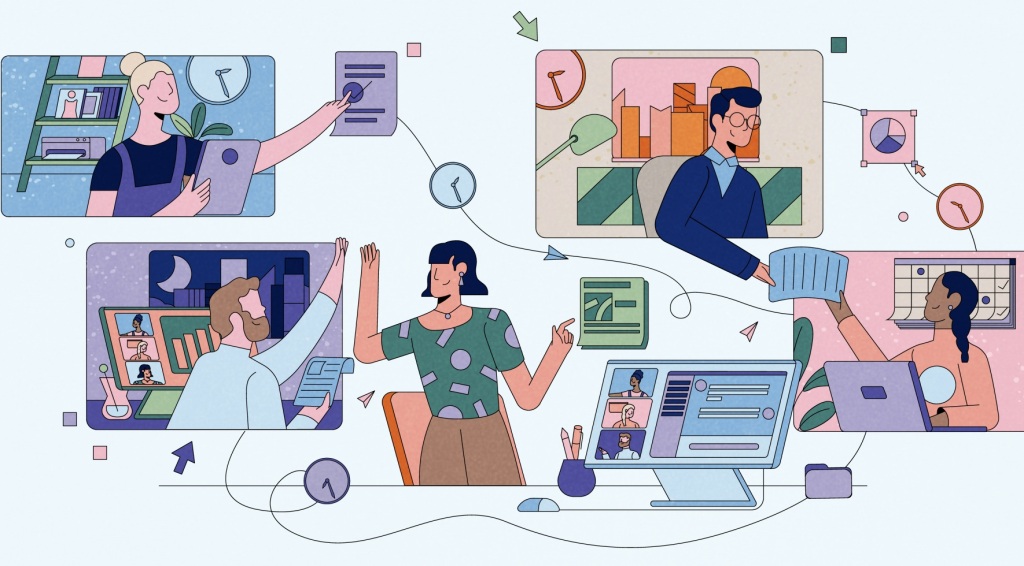
Virtual collaboration is the method of collaboration between virtual team members that is carried out via technology-mediated communication. The collaborators are physically separated from each other and can only interact virtually.
Realizing true collaboration — in which the whole is positively more than the mere sum of the individual parts — is intricate in any environment. Individuals have to set aside their egos, trust one another, and share their expertise willingly.
In a virtual workplace, collaboration can be all the more difficult to attain, especially when team members work for different groups/ teams, are essentially strangers to one another, and have different cultural and professional backgrounds.
Virtual collaboration holds amazing promise. When successful, it enables talented peers to work together regardless of location and organizations to mine the collective wisdom of a widely dispersed employee population. It is paramount to organisations that want to succeed in today’s business climate. But virtual collaboration comes with its own unique challenges — especially for leaders whose previous experience has been mainly with collocated teams, such as:-
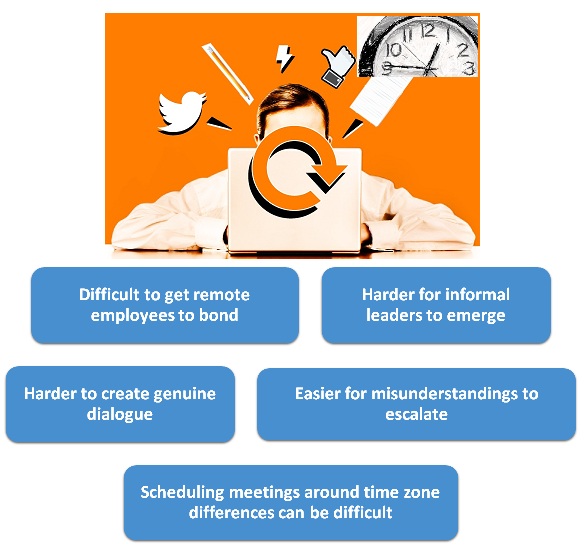
Organization Commitment Is Absolutely Essential
Organisations need to empower and enable collaborative processes that connect employees in every department and provide them with better access to information. Today’s companies have a bewildering variety of collaborative tools at their fingertips. With everything from team calendars and discussion platforms to document and screen sharing software, modern technologies deliver remarkable improvements in the ability for companies to collaborate across locations and time zones.
Attune For Dimension
Teams have been getting larger and larger, some even exceeding 100 people for complex projects and this trend has made true collaboration increasingly difficult to achieve. One solution is to use a flexible, fluid team structure that consists of three tiers: a core, an operational level, and an outer network. Using this hierarchy groups together those who need to collaborate with one another for particular purposes, and exclude others who aren’t important to that process. Another tool is the Relationship Action Plan, which can be used to manage an organization around loosely configured, flexible teams.
Apprehensions With Social Media
People are more prone to collaborate with others who are similar to them. The trick is to find the common ground between such individuals, and social media — blogs, wikis, online collaboration tools, etc. — can play a huge role in doing so. Those companies that have begun to use social media for internal purposes are starting to reap the benefits.
Virtual Games
Another effective way to get team members in the right mindset for working together is to have everyone play virtual games that encourage collaboration. Such games can be customized to a particular company so that players have to pool their knowledge and internal connections to find solutions.
Some examples of online role-playing games are “Scavenger Hunt”, “World of Warcraft” and “EverQuest”. In such multiplayer games, players must collaborate to survive in a fast-changing environment with fierce competitors and incomplete or ambiguous information from which to base important decisions — that is, an environment not unlike many hypercompetitive global markets.
Leaders, for instance, will often step down to allow others who are more qualified to take the reins. This helps encourage leadership, an atmosphere of collaboration as well as sacrifice for the greater good of the team.
Train For Collaboration.
Many skills are difficult to train and develop. Some experts, for example, contend that leadership is more nature than nurture. Not so with collaboration. PricewaterhouseCoopers, for instance, has had great success in training employees to collaborate by targeting communication skills, emotional intelligence, teamwork, and networking.
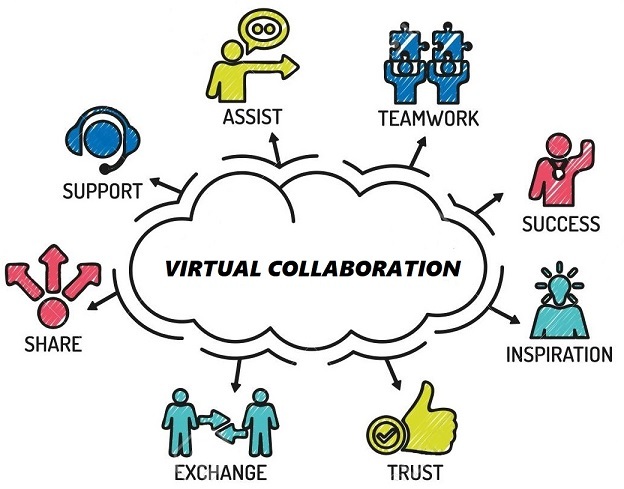
Emotional intelligence
Business school professor Amy Edmondson’s Brightline Initiative TED Talk reflects on the concept of teaming: a situation where strangers come together quickly to solve problems despite distance, expertise, time zones, and status. While our colleagues and coworkers aren’t complete strangers, these unprecedented times and working conditions certainly are.
So, how can teaming solve this issue? Edmondson shares three key qualities that have contributed to teaming success:
- Humble in the face of challenges ahead
- Curious about what others bring
- Willing to take risks to learn quickly
When a group of strangers (or a group of people working in strange conditions) all do their best to exercise emotional intelligence and stay humble by creating situational humility, remain curious by embracing diverse opinions, and are willing to take risks to learn quickly, then problem solving in a virtual world will be easier than ever before.
Have Role Clarity But Task Uncertainty.
Many managers believe that teams collaborate best when the roles of members are flexible but the group has a clear idea of how to get from A to B. But the reverse is actually true, according to a study of more than 50 teams in different industries. That research found that collaboration increased when people had clearly defined roles but were uncertain about how to achieve the team’s goals. The uncertainty encouraged everyone to collaborate and think more creatively about different ways in which to accomplish the group’s mission.

Increase Cross-Cultural Awareness
The first thing that everyone on an international team should do is to understand the challenges that various global team members face. For example, most of the international organizations in my environment conduct their virtual meetings in English. This often results in “code switching,” where participants in remote locations switch back to their native language in “off-line” conversations about items covered in the meeting. When that happens, the English language speakers report feeling dismissed and left out.
A frank discussion of the difficulty of processing information in a second language (on one side) and the feelings of exclusion (on the other) can bring increased understanding and empathy for all concerned.
Co-Create Team Rules And Norms
It is important for all collaborative teams, but absolutely essential for cross-cultural and virtual teams, to understand and agree upon standards and expectations for communication, decision-making, conflict resolution, and meeting protocol. Equally important is the clarification of priorities as well as each individual’s role, responsibility, and accountability.

Build Virtual Trust
With collocated teams, trust grows out of mutual work experiences and personal interactions – usually extended over time. Virtual teams don’t share this context. Members often have no idea of the work environments of their counterparts, nor do they have insights into a teammate’s work ethic, past performance, or personal life. Strategies that help remote teams bond, so that participants can build or deepen personal relationships,include:-
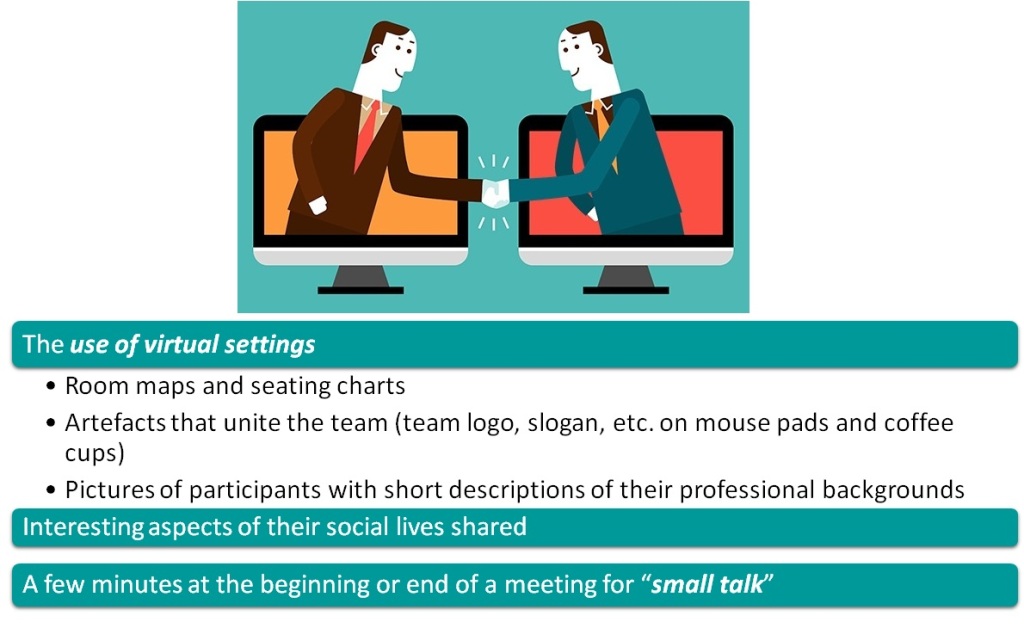
Blended Communication Mediums
Communication mediums run a spectrum from “lean” to “rich.” A lean medium transmits less information than a rich medium. For example, if you are emailing, texting or typing in a chat window (lean mediums), there is nothing that gives added clues to the meaning of what you write. Because they lack social signals, lean mediums are poor transmitters of emotion, intent, or humor. But when the message is straightforward and easy to understand, a lean channel is fine.
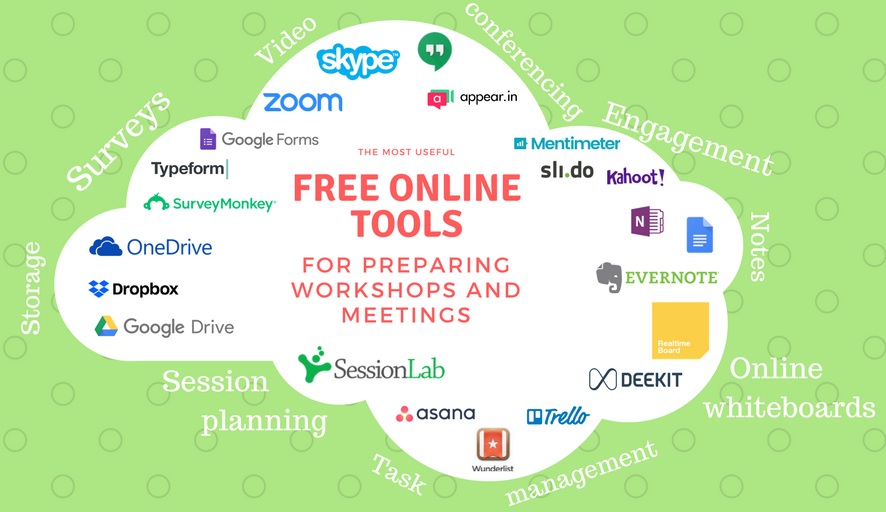
The more complicated, emotional, or nuanced your message is, the richer your channel should be. A communication channel becomes richer as you add human elements. Telephone calls and teleconferences give listeners access to vocal clues. Videoconferencing allows participants to view facial expressions and hand gestures.
The ‘Face To Face’ Advantage
In face-to-face meetings, our brains process the continual cascade of nonverbal cues that we use as the basis for trust and professional intimacy. Face-to-face interaction is an information-rich communication channel in which voice, body language, proximity and eye contact are all present to give deeper meaning to our messages – and to allow us to gauge the instantaneous responses of others.
Content Curated By: Dr Shoury Kuttappa.

